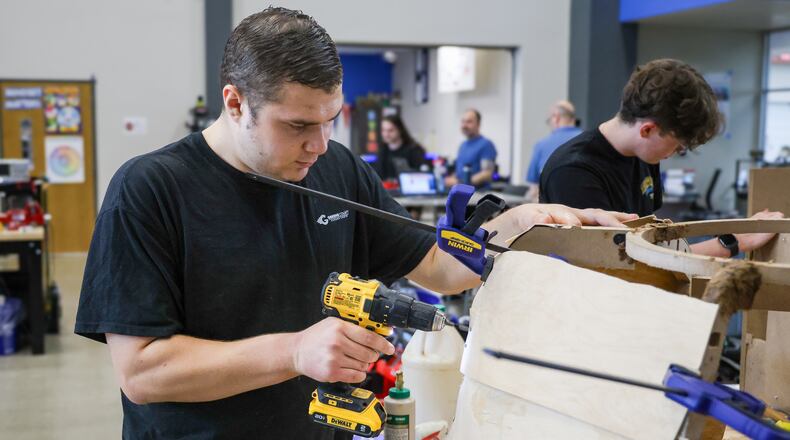The Springfield-Clark Career Technology Center (CTC) is just about to start the new construction process that career centers in Greene and Montgomery County finished in recent years.
Voters approved a bond issue in November that will help pay for a new school facility south of the current administrative building. It will be 29,000 square feet larger than the current 182,000 square-foot campus.
Credit: Bill Lackey
Credit: Bill Lackey
The CTC’s seven existing buildings at 1901 Selma Road house just over 750 students, and Superintendent Michelle Patrick said the 60-year-old campus has seen a number of updates, renovations and additions over the years.
But those changes still left the CTC with a waitlist — currently 185 students, down from 195 at this time last year.
Patrick said being on a waitlist doesn’t always mean a student will be shut out. Between acceptances in February and the beginning of the school year in August, some students move or change their minds, which leaves openings that students from the waitlist can be moved into.
“Every student deserves a career, and we are at a time in which the career-tech education model has gained positive momentum as a great step in the right direction for the right students for the right reasons,” Patrick said.
Credit: Bill Lackey
Credit: Bill Lackey
Patrick said Springfield’s CTC expects the waitlist to shrink thanks to several adjustments to accommodate additional students, such as adding an educational aide to the culinary arts program to allow more students to enroll in that program and adding virtual options for academic classes, since space is limited.
One of the reasons career tech waitlists continue is a simple increase in demand in recent years. Springfield-Clark CTC currently has 861 applicants, an increase from last year’s 771. The center is on track to start the 2025-26 school year with 529 new students, compared to starting with 475 last year.
Springfield CTC has 23 career-tech programs and three career exploration programs, with all but three at full capacity for the upcoming school year (cybersecurity, software programming technologies, and forestry and park management have openings).
Credit: Bill Lackey
Credit: Bill Lackey
The top 10 in-demand programs based on the number of applicants are culinary, cosmetology, health occupations, criminal justice, veterinary science, welding, carpentry, electrical trades, education exploration and dental assisting.
Career-tech schools offer direct pathways to high-demand jobs, often with industry credentials, certifications or college credits, Patrick said, as well as more applied, hands-on learning that appeals to students who “may not thrive in traditional academic settings.”
“Students (and parents) see the immediate value in graduating with skills that lead to employment or apprenticeships without the burden of college debt,” she said. “Career-tech schools are shedding outdated stereotypes of being for “non-college-bound” students. With the availability of college credit courses and the increase of students using career-tech as a launch pad for college, families and students increasingly see career-tech as a first-choice option rather than a fallback."
Credit: Bill Lackey
Credit: Bill Lackey
Other local career tech superintendents say that their waitlists persist, not because of inadequate investment in the present day, but rather because of a chronic failure to invest — both financially and culturally — in career tech students over the past 20 years.
“It was not hard to predict. Everybody knew there wasn’t that many people going into the trades 10 years ago. You could plot it on a graph and see a problem was coming,” Miami Valley Career Tech Center Superintendent Nick Weldy said. “I started talking to different groups 10 years ago … I’d visit different businesses and I’d say ‘You‘ve got a hair problem ... Everyone in here has either gray hair or no hair.’”
Investments, waitlists growing
Miami Valley CTC opened their nearly 600,000-square-foot school building in Montgomery County last year, after almost five years of renovations. The $158 million renovation and expansion ($28 million of which was from the Ohio Facilities Construction Commission and millions from a 2017 bond issue approved by voters) expanded the school’s capacity from roughly 1,600 to 2,250 kids.
Simultaneously, MVCTC‘s waitlist has also grown from its historical average of 200-300 students.
“If we could have taken those extra, let’s say 300 kids (at the time), we would have been up to 1,900,” Weldy said. “Now we‘re up to 2,203, so not only did we take all those kids … we have gone above and beyond that, and we expect, actually, that the 2,203 number will reach 2,300. That’s probably going to be our absolute max.”
But MVCTC‘s waitlist has swelled to 534 students.
Many of those waitlisted are for specific programs. Health sciences, cosmetology, veterinary science, electrical, heavy equipment and welding are among the most highly requested programs in career tech schools across the Miami Valley.
Credit: Bryant Billing
Credit: Bryant Billing
MVCTC offers 43 career-technical programs, and nearly all are projected to be at full capacity for the 2025–2026 school year.
The Greene County Career Center opened their campus just off U.S. 35 near U.S. 68 in 2020. The $70 million facility raised the career center’s capacity to 950 students, a number the career center exceeded two years ago.
Greene County’s waitlist has about 100 students.
“Next year, I think we‘re scheduled to have just under 1,100 students on campus,” Superintendent Dave Deskins said. “We are long at capacity already in our existing space.”
Butler Tech, Upper Valley
The much larger Butler Tech north of Cincinnati has several major expansions to its five campuses currently in the works: a $12.1 million expansion to its Bioscience Center, a $30 million Advanced Manufacturing Hub, developed with Miami University, and a $15 million Aviation Education Hangar at Middletown Regional Airport. All three of these are planned to open in January 2026.
“Rather than eliminate programs, Butler Tech’s strategy is to expand capacity and flexibility across multiple campuses and offer modular, short-term credentials to serve a broader student base,” said AJ Huff, public relations coordinator for Butler Tech.
Credit: Bill Lackey
Credit: Bill Lackey
Butler Tech serves 18,000 students across all five campuses, though that number encompasses both adults and career tech high school programs, Huff said. Waiting lists for the schools vary by program.
Upper Valley Career Tech Center in Piqua is also in the middle of its own $18 million expansion, benefiting its Medical Careers Academy, First Responders Academy, sports medicine program, construction technologies, electrical trades, robotics, maintenance, and manufacturing and machining.
Upper Valley’s waiting list is 247 students.
Warren County
Last year, voters rejected a bond issue to fund a long-term plan to build a secondary campus for the Warren County Career Center. The entire project would have cost about $88.9 million, as the Ohio Facilities Construction Commission — which provides state dollars to build qualifying new government buildings — would have provided $21.7 million, or about 24%, if voters had approved the local share via the new tax.
Credit: Bryant Billing
Credit: Bryant Billing
Warren County CC also lost a $6 million career tech expansion grant for fire, EMS, and law enforcement training because of the ballot measure, Superintendent Joel King said. One of the conditions of the grant was that the school not try to pass a new money levy, which King said the school was unaware of when they voted to put the levy on the ballot.
Despite not having access to similar financial resources as other local schools, Warren County has undergone some major changes in the last five years. These include establishing their veterinary sciences program in 2020, and expanding its health science campus and welding programs around the same time, King said.
Warren County’s waitlist has grown from roughly 130 students last year, to around 200.
Warren County’s adult education enrollment is also surging, but the age group for those classes are trending younger, he added.
“We‘re starting to see that demographic of late teens to early and mid-twenties enroll in our adult education programs,” King said. “What we‘re seeing is many of them not having college degrees, but maybe they went for a semester and realized ‘college wasn’t for me, and there are job opportunities where I can make a lot of money.’”
Should we have built bigger?
When asked if he thought MVCTC should have built bigger, Weldy says they tried.
“The OFCC requires that you do an enrollment study and they use their vendor to do it,” he said. “We did not have a say. And we actually went back to them two or three times and said ‘This is not enough.’ ”
The Greene County Career Center school board has a few options to accommodate this growth, Deskins said, including expanding existing programs on campus, but also expanding “satellite” programs taught at Greene County high schools’ own campuses.
These classes, led by career center teachers, but located at students’ home schools, give students access to career center opportunities, while staying in one place, a model mirrored in career tech schools across the Miami Valley in various forms.
The satellite model also gives students who are not enrolled in career tech programs a taste of what jobs are available, as oftentimes high schoolers don’t know what opportunities and careers are available to them.
Greene County even has age-appropriate career tech materials that are given out to first graders, including coloring and activity books, that aim to increase awareness among parents and students about possible career opportunities that are right for them.
“I believe that by us having a vision out, we‘re fixing this problem that we‘ve not done a good job on (fixing) so far, which is waiting until we‘re in crisis and trying to react,” Deskins said.
“We want those students to be looking for jobs that give them life sustaining wages. By providing the credentials, the certifications, the competencies that they need for those different positions, we‘re giving those students an advantage, whether they choose to go on to school, or whether they decide to look at different options.”











